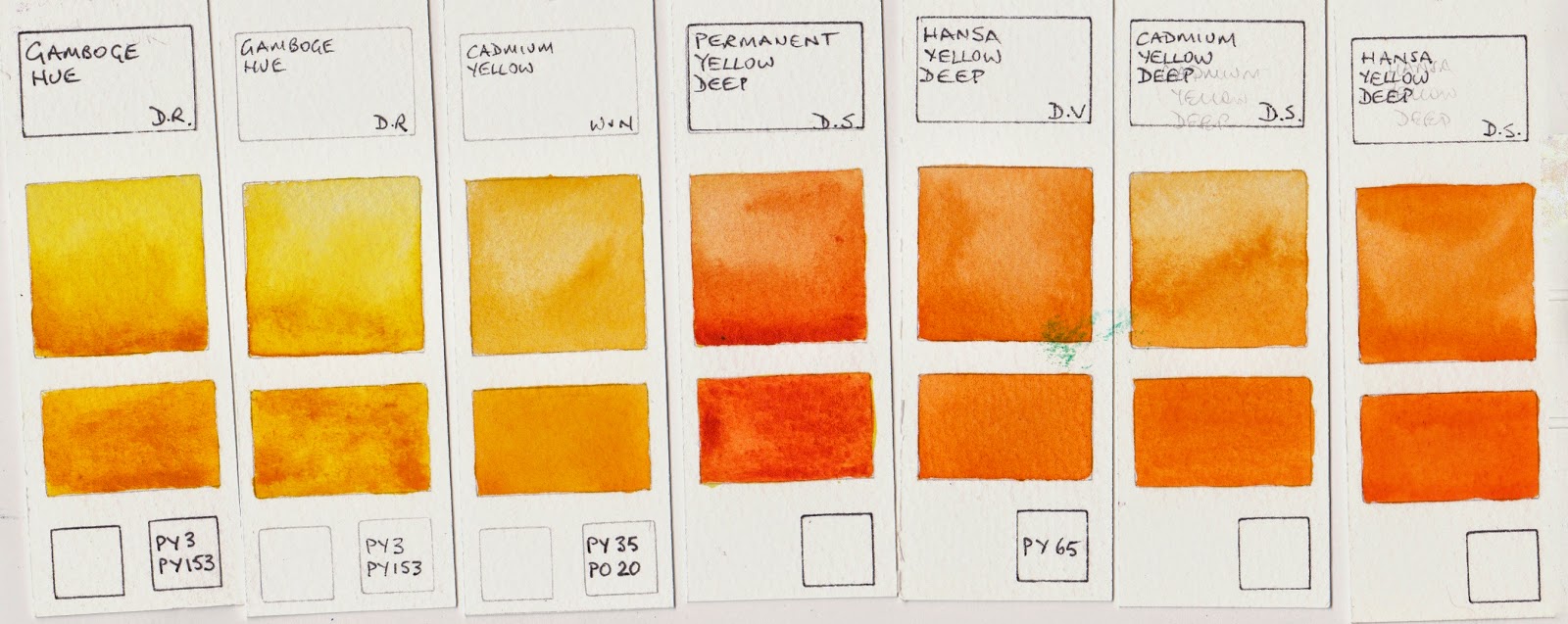I have been exploring limited palette options again and came up with this set. This is an unusual palette of watercolours for me as it doesn't contain Ultramarine, my favourite blue, or Burnt Sienna, my favourite earth orange, and it does contain Quinacridone Magenta though that is not a favourite! Note this is called Purple Magenta in Schmincke or Quinacridone Lilac in Daniel Smith - who added this pigment to their range in 2017. I find it a difficult 'real world' colour and would generally rather use a rose or crimson. However, PR122 is an amazing mixing colour which, like phthalo green, can transform other colours beautifully and mixes very cleanly but in my opinion is best not used alone.
This quartet of colours is designed to be transparent, bright and non granulating - a bit like working with inks - and works beautifully!
It is based around a fabulous pair of transparent watercolours -
Transparent Pyrrol Orange DS and
Phthalo Blue RS DS. These neutralise each other completely to create a fantastic range of greys, black, warm browns and burnt oranges. See the first colour mixing row 1.
Other manufacturers make Phthalo blue RS (or Winsor Blue RS) but I have not found an alternative brand for this orange. Schmincke make Translucent Orange with the same pigment but it is not as red. (see separate post on oranges and blues) QoR also make a transparent pyrrol orange but it is not the same hue. As mentioned in the comments below, I'd recommend using Daniel Smith with or without Schmincke for this set, but I find W&N colours can fight with DS colours so I don't suggest mixing those brands.
 |
| Hansa Yellow Medium PY97 Daniel Smith, Purple Magenta PR122 Schmincke (or use the new DS Quinacridone Lilac), Phthalo Blue R.S. PB15 Daniel Smith and Transparent Pyrrol Orange PO71 Daniel Smith. |
To make oranges and greens a mid yellow is added - Hansa
Yellow Medium PY97 DS, though it could be Schmincke Pure Yellow or W&N Winsor Yellow or DV Hansa/Arylide Yellow Medium. This is a lovely bright yellow. for even more transparency it could also be a PY150 yellow such as DS Nickel Azo Yellow but I like the purity of Hansa Yellow Medium.
2 - Hansa Yellow Medium mixed with Transparent Pyrrol Orange PO71 DS
4 - Hansa Yellow Medium mixed with Phthalo Blue RS PB15 DS to make bright greens.
To make purples and reds and crimsons the very bright Magenta PR122 is required. This was not made by Daniel Smith when I created this post (I often wondered why not) but was added to the range in 2017 and is called Quinacridone Lilac. Is also available as Purple Magenta by Schmincke or Quinacridone Magenta in many other brands including W&N, Daler Rowney, Old Holland, and QoR. It is often used as a primary red pigment. I prefer the Schmincke version or the new DS version. The advantage of this pigment over my usual preferred PV19 Quinacridone Rose is that it will create a rich crimson when mixed with Transparent Pyrrol Orange.
3 - Mixed with the DS Transparent Pyrrol Orange it creates gorgeous reds and crimsons
5 - Mixed with Phthalo Blue RS it makes amazing purples
6 - I mixed Purple Magenta with Yellow as they also make wonderful oranges, reds and crimsons.
You can see how easy it is to create bright mixes of oranges, greens and purples.
7 - I then added a little magenta to the Phthalo Blue RS to create a warmer blue, which made more neutral greens when yellow was added
8 - I did the same thing adding some Transparent Pyrrol Orange to the yellow to made it warmer, then adding the blue to make more mossy greens
9 - The last row is all three primaries mixed together to create a range of darks and neutral earth hues.
Another very bright transparent and non-granulating pigment is Phthalo Green PG7. I use this for many mixes, especially to make a rich black with a crimson. I mixed it with the Purple Magenta (1 below) to see if it would neutralise to black. Like Quinacridone Rose, it makes great purples but not black.
 |
| Mixes with my amazing quartet along with Phthalo Green PR7. |
2 - I mixed a crimson hue by mixing Transparent Pyrrol Orange with Purple Magenta, then mixed that crimson with Phthalo Green and yes - blacks and aubergines are possible.
3 - back to my bright quartet colours, I tested the yellow to see what earth yellows I could create just with my initial 4 colours. Alone mixed with a purple made from the blue and magenta, hansa yellow medium creates some interesting cool earth colours.
4 - With a little orange added Hansa Yellow Medium creates yellow ochre and raw sienna hues and some raw umber options.
5 - I tried mixing a crimson from the magenta and orange then creating a phthalo green hue to try to create the same aubergine and black options. It comes close, though required all four pigments. I try to steer away from 4 pigment mixes but it is possible.
So I think a phthalo green is a useful addition if you want to limit yourself to three pigment mixes but increase to 5 bright transparent colours. Phthalo Green yellow shade would be the best option as it neutralises magenta to a grey. And if you want a 6th? A purple is the obvious choice for a balanced palette. Such lovely sets of 6 can be seen
here, but as purple is very easy to mix, I'd rather add Quinacridone Gold DS :-)
My next tests will be with Ultramarine instead of Phthalo Blue RS to see if I can find a completely neutralising bright orange........ see
here.
Happy painting!

















































